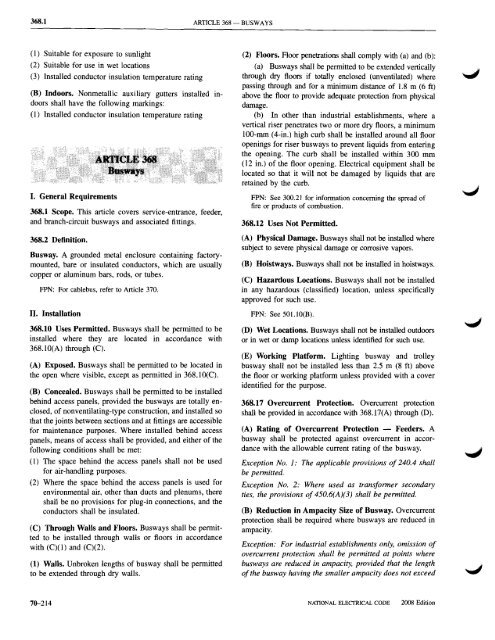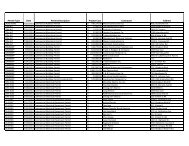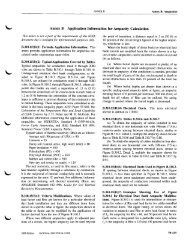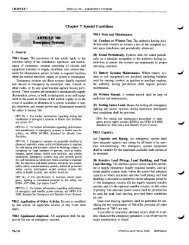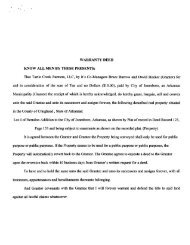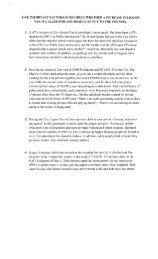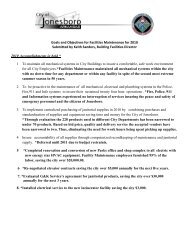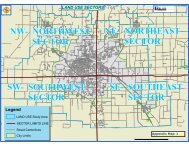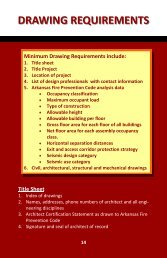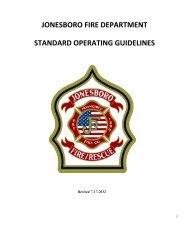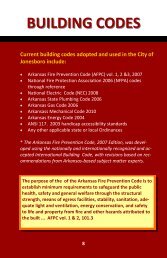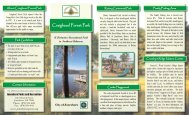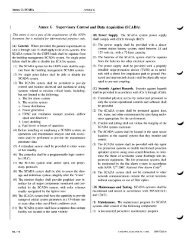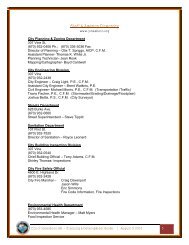Chapter 3 Wiring Methods and Materials
Chapter 3 Wiring Methods and Materials
Chapter 3 Wiring Methods and Materials
You also want an ePaper? Increase the reach of your titles
YUMPU automatically turns print PDFs into web optimized ePapers that Google loves.
368.1 ARTICLE 368 - BUSWAYS<br />
(I) Suitable for exposure to sunlight<br />
(2) Suitable for use in wet locations<br />
(3) Installed conductor insulation temperature rating<br />
(B) Indoors. Nonmetallic auxiliary gutters installed indoors<br />
shall have the following markings:<br />
(I) Installed conductor insulation temperature rating<br />
I. General Requirements<br />
368.1 Scope. This article covers service-entrance, feeder,<br />
<strong>and</strong> branch-circuit busways <strong>and</strong> associated fittings.<br />
368.2 Definition.<br />
Busway. A grounded metal enclosure containing factorymounted,<br />
bare or insulated conductors, which are usually<br />
copper or aluminum bars, rods, or tubes.<br />
FPN: For cablebus, refer to Article 370.<br />
II. Installation<br />
368.10 Uses Permitted. Busways shall be permitted to be<br />
installed where they are located in accordance with<br />
368.1O(A) through (C).<br />
(A) Exposed. Busways shall be permitted to be located in<br />
the open where visible, except as permitted in 368.1O(C).<br />
(B) Concealed. Busways shall be permitted to be installed<br />
behind access panels, provided the busways are totally enclosed,<br />
of nonventilating-type construction, <strong>and</strong> installed so<br />
that the joints between sections <strong>and</strong> at fittings are accessible<br />
for maintenance purposes. Where installed behind access<br />
panels, means of access shall be provided, <strong>and</strong> either of the<br />
following conditions shall be met:<br />
(I) The space behind the access panels shall not be used<br />
for air-h<strong>and</strong>ling purposes.<br />
(2) Where the space behind the access panels is used for<br />
environmental air, other than ducts <strong>and</strong> plenums, there<br />
shall be no provisions for plug-in connections, <strong>and</strong> the<br />
conductors shall be insulated.<br />
(C) Through Walls <strong>and</strong> Floors. Busways shall be permitted<br />
to be installed through walls or floors in accordance<br />
with (C)(l) <strong>and</strong> (C)(2).<br />
(1) Walls. Unbroken lengths of busway shall be permitted<br />
to be extended through dry walls.<br />
(2) Floors. Floor penetrations shall comply with (a) <strong>and</strong> (b):<br />
(a) Busways shall be permitted to be extended vertically<br />
through dry floors if totally enclosed (unventilated) where<br />
passing through <strong>and</strong> for a minimum distance of 1.8 m (6 ft)<br />
above the floor to provide adequate protection from physical<br />
damage.<br />
(b) In other than industrial establishments, where a<br />
vertical riser penetrates two or more dry floors, a minimum<br />
100-mm (4-in.) high curb shall be installed around all floor<br />
openings for riser busways to prevent liquids from entering<br />
the opening. The curb shall be installed within 300 mm<br />
(12 in.) of the floor opening. Electrical equipment shall be<br />
located so that it will not be damaged by liquids that are<br />
retained by the curb.<br />
FPN: See 300.21 for information concerning the spread of<br />
fire or products of combustion.<br />
368.12 Uses Not Permitted.<br />
(A) Physical Damage. Busways shall not be installed where<br />
subject to severe physical damage or corrosive vapors.<br />
(B) Hoistways. Busways shall not be installed in hoistways.<br />
(C) Hazardous Locations. Busways shall not be installed<br />
in any hazardous (classified) location, unless specifically<br />
approved for such use.<br />
FPN: See 501.1O(B).<br />
(D) Wet Locations. Busways shall not be installed outdoors<br />
or in wet or damp locations unless identified for such use.<br />
(E) Working Platform. Lighting busway <strong>and</strong> trolley<br />
busway shall not be installed less than 2.5 m (8 ft) above<br />
the floor or working platform unless provided with a cover<br />
identified for the purpose.<br />
368.17 Overcurrent Protection. Overcurrent protection<br />
shall be provided in accordance with 368.17(A) through (D).<br />
(A) Rating of Overcurrent Protection - Feeders. A<br />
busway shall be protected against overcurrent in accordance<br />
with the allowable current rating of the busway.<br />
Exception No.1: The applicable provisions of 240.4 shall<br />
be permitted.<br />
Exception No.2: Where used as transformer secondary<br />
ties, the provisions of 450.6(A)(3) shall be permitted.<br />
(B) Reduction in Ampacity Size of Busway. Overcurrent<br />
protection shall be required where busways are reduced in<br />
ampacity.<br />
Exception: For industrial establishments only, omission of<br />
overcurrent protection shall be permitted at points where<br />
busways are reduced in ampacity, provided that the length<br />
ofthe busway having the smaller ampacity does not exceed<br />
70-214<br />
NATIONAL ELECfRICAL CODE<br />
2008 Edition


